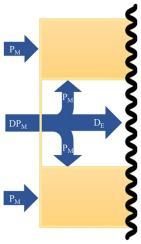Chemical Engineering Research and Design ( IF 3.7 ) Pub Date : 2021-06-18 , DOI: 10.1016/j.cherd.2021.05.029 R. Leyva-Ramos , J.J. Salazar-Rábago , R. Ocampo-Pérez

|
The removal of contaminants from water solution by biosorption on biowaste materials, such as natural wood sawdust (NWS), has been extensively studied recently. The interpretation of the experimental biosorption rate data is an important issue and has to be performed using mathematical models based upon phenomenological principles. An experimental stirred tank batch adsorber was employed to obtain the biosorption rate data of methylene blue (MB) on NWS, which were interpreted using kinetic and diffusional models. The pseudo-second order (PSO) kinetic model adequately represented the experimental data, but its kinetic constant changed significantly with the operating conditions, hampering its practical application. A new diffusion-permeation model (DPM) is proposed by assuming that the intraparticular transport of pollutants is due to the simultaneous diffusion in the voids and permeation through the biosorbent walls. The DPM model fitted the experimental data satisfactorily, and the diffusion-permeation coefficient, DPM, varied slightly with the experimental conditions. The DPM model matched the experimental data adequately using an arithmetic mean of the DPM coefficient, . Finally, the predictions of the DPM model using were compared to those estimated with the PSO model. In most of the experimental cases, the experimental data was better predicted by the DPM model.
中文翻译:

白松 (Pinus durangensis) 锯末上亚甲蓝生物吸附率的新型颗粒内传质模型。扩散渗透
最近已经广泛研究了通过生物废物材料(例如天然木屑(NWS))上的生物吸附去除水溶液中的污染物。实验生物吸附速率数据的解释是一个重要问题,必须使用基于现象学原理的数学模型进行。实验性搅拌罐间歇式吸附器用于获得亚甲基蓝 (MB) 在 NWS 上的生物吸附速率数据,这些数据使用动力学和扩散模型进行解释。伪二级(PSO)动力学模型充分代表了实验数据,但其动力学常数随操作条件发生显着变化,阻碍了其实际应用。通过假设污染物的颗粒内传输是由于空隙中的同时扩散和通过生物吸附剂壁的渗透,提出了一种新的扩散-渗透模型 (DPM)。DPM 模型与实验数据拟合良好,扩散渗透系数 DPM,随实验条件略有变化。在DPM模型的实验数据充分使用DP的算术平均值匹配中号系数,. 最后,使用 DPM 模型的预测与 PSO 模型估计的结果进行比较。在大多数实验案例中,DPM 模型对实验数据进行了更好的预测。









































 京公网安备 11010802027423号
京公网安备 11010802027423号